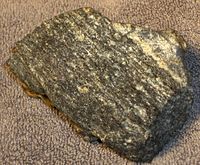

The oldest dated rocks formed on Earth, as an aggregate of minerals that have not been subsequently broken down by erosion or melted, are more than 4 billion years old, formed during the Hadean Eon of Earth's geological history, and mark the start of the Archean Eon, which is defined to start with the formation of the oldest intact rocks on Earth.
Archean rocks are exposed on Earth's surface in very few places, such as in the geologic shields of Canada, Australia, and Africa. The ages of these felsic rocks are generally between 2.5 and 3.8 billion years. The approximate ages have a margin of error of millions of years. In 1999, the oldest known rock on Earth was dated to 4.031 ±0.003 billion years, and is part of the Acasta Gneiss of the Slave Craton in northwestern Canada.[1] Researchers at McGill University found a rock with a very old model age for extraction from the mantle (3.8 to 4.28 billion years ago) in the Nuvvuagittuq greenstone belt on the coast of Hudson Bay, in northern Quebec;[2] the true age of these samples is still under debate, and they may actually be closer to 3.8 billion years old.[3] Older than these rocks are crystals of the mineral zircon, which can survive the disaggregation of their parent rock and be found and dated in younger rock formations.
In January 2019, NASA scientists reported the discovery of the oldest known Earth rock, found on the Moon. Apollo 14 astronauts returned several rocks from the Moon and, later, scientists determined that a fragment from a rock nicknamed Big Bertha, which had been chosen by astronaut Alan Shepard, contained "a bit of Earth from about 4 billion years ago". The rock fragment contained quartz, feldspar, and zircon, all common on Earth, but highly uncommon on the Moon.[4] Pre-solar grains in meteorites are older than the Solar System, with some grains extracted from the Murchison meteorite claimed to be 7 billion years old.[5][6][7]
- ^ Bowring, Samuel A.; Williams, Ian S. (1999). "Priscoan (4.00–4.03 Ga) orthogneisses from northwestern Canada". Contributions to Mineralogy and Petrology. 134 (1): 3. Bibcode:1999CoMP..134....3B. doi:10.1007/s004100050465. S2CID 128376754.
- ^ Thompson, Andrea (25 September 2008). "Oldest Rocks on Earth Found". Live Science.
- ^ Discovery of world's oldest rocks challenged
- ^ Cite error: The named reference
NASA-20190124was invoked but never defined (see the help page). - ^ Lyons, Suzannah (13 January 2020). "Grains of stardust found in meteorite that landed in Victoria". ABC News (Australia) - Science.
- ^ Weisberger, Mindy (13 January 2020). "7 Billion-Year-Old Stardust Is Oldest Material Found on Earth - Some of these ancient grains are billions of years older than our sun". Live Science. Retrieved 13 January 2020.
- ^ Heck, Philipp R.; et al. (13 January 2020). "Lifetimes of interstellar dust from cosmic ray exposure ages of presolar silicon carbide". Proceedings of the National Academy of Sciences of the United States of America. 117 (4): 1884–1889. Bibcode:2020PNAS..117.1884H. doi:10.1073/pnas.1904573117. PMC 6995017. PMID 31932423.